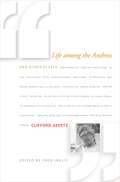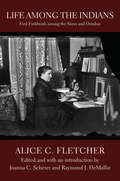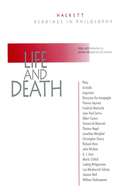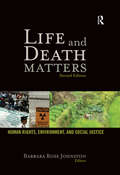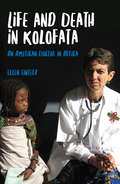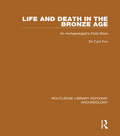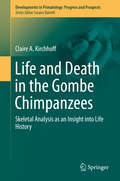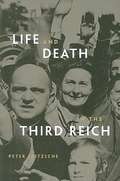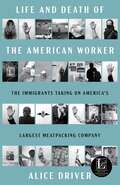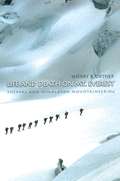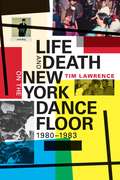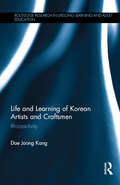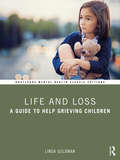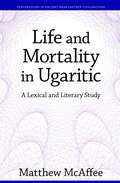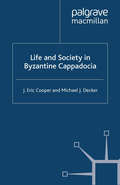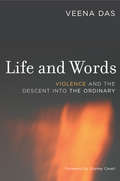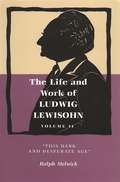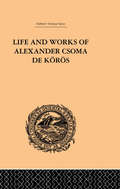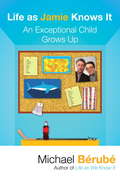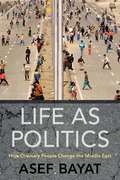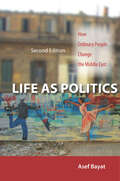- Table View
- List View
Life among the Anthros and Other Essays
by Clifford GeertzAn incomparable retrospective of writings by one of the world's great anthropologistsClifford Geertz (1926–2006) was perhaps the most influential anthropologist of our time, but his influence extended far beyond his field to encompass all facets of contemporary life. Nowhere were his gifts for directness, humor, and steady revelation more evident than in the pages of the New York Review of Books, where for nearly four decades he shared his acute vision of the world in all its peculiarity. This book brings together the finest of Geertz's review essays from the New York Review along with a representative selection of later pieces written at the height of his powers, some that first appeared in periodicals such as Dissent, others never before published.This collection exemplifies Geertz's extraordinary range of concerns, beginning with his first essay for the Review in 1967, in which he reviews, with muffled hilarity, the anthropologist Bronislaw Malinowski. This book includes Geertz's unflinching meditations on Western academia's encounters with the non-Western world, and on the shifting and clashing places of societies in the world generally. Geertz writes eloquently and arrestingly about such major figures as Gandhi, Foucault, and Genet, and on topics as varied as Islam, globalization, feminism, and the failings of nationalism.Life among the Anthros and Other Essays demonstrates Geertz's uncommon wisdom and consistently keen and hopeful humor, confirming his status as one of our most important and enduring public intellectuals.
Life among the Indians: First Fieldwork among the Sioux and Omahas (Studies in the Anthropology of North American Indians)
by Alice C. FletcherAlice C. Fletcher (1838–1923), one of the few women who became anthropologists in the United States during the nineteenth century, was a pioneer in the practice of participant-observation ethnography. She focused her studies over many years among the Native tribes in Nebraska and South Dakota.Life among the Indians, Fletcher&’s popularized autobiographical memoir written in 1886–87 about her first fieldwork among the Sioux and the Omahas during 1881–82, remained unpublished in Fletcher&’s archives at the Smithsonian Institution for more than one hundred years. In it Fletcher depicts the humor and hardships of her field experiences as a middle-aged woman undertaking anthropological fieldwork alone, while showing genuine respect and compassion for Native ways and beliefs that was far ahead of her time. What emerges is a complex and fascinating picture of a woman questioning the cultural and gender expectations of nineteenth-century America while insightfully portraying rapidly changing reservation life. Fletcher&’s account of her early fieldwork is available here for the first time, accompanied by an essay by the editors that sheds light on Fletcher&’s place in the development of anthropology and the role of women in the discipline.
Life and Death Matters: Human Rights, Environment, and Social Justice, Second Edition
by Barbara Rose JohnstonThe first edition of Life and Death Matters was a breakthrough text, centralizing the experiences of those on the front lines of environmental crises and forging new paradigms for understanding how crises emerge and how different groups of actors respond to them. This second edition, fully updated with both expanded and new chapters, once again provides a benchmark for the field and opens important pathways for further research. Authors reassess the state of scholarship and grassroots activism in a new century when social and environmental systems are being reconceptualised within post-9/11 security and biosecurity frameworks, when global warming and resource scarcity are not fears but realities, when global power and politics are being realigned, and when ecocide, ethnocide, and genocide are daily tragedies. This bold new edition of Life and Death Matters will be a widely used textbook and essential reading for students, scholars, and policy makers.
Life and Death in Kolofata: An American Doctor in Africa
by Ellen EinterzWhen Dr. Ellen Einterz first arrives in the town of Kolofata in Cameroon, the situation is dire: patients are exploited by healthcare workers, unsterilized needles are reused, and only the wealthy can afford care. In Life and Death in Kolofata: An American Doctor in Africa, Einterz tells her remarkable story of delivering healthcare for 24 years in one of the poorest countries in the world, revealing both touching stories of those she is able to help and the terrible suffering of people born in extreme poverty. In one case, a 6-year-old burn victim suffers after an oil tanker tips and catches fire; in another story, Dr. Einterz delivers a child in the front yard of her home. In addition to struggling to cure diseases and injuries and combat malnutrition, Einterz faced another kind of danger: the terrorist organization Boko Haram had successively kidnapped foreigners from Cameroon, and they had set their sights on the American in Kolofata. It would only be a matter of time before they would come for her. Tragic, heartwarming, and at times even humorous, Life and Death in Kolofata illustrates daily life for the people of Cameroon and their doctor, documenting both the incredible human suffering in the world and the difference that can be made by those willing to help.
Life and Death in Rikers Island
by Homer VentersShining a light on the deadly health consequences of incarceration.Finalist in the PROSE Award for Best Book in Anthropology, Criminology, and Sociology by the Association of American PublishersKalief Browder was 16 when he was arrested in the Bronx for allegedly stealing a backpack. Unable to raise bail and unwilling to plead guilty to a crime he didn't commit, Browder spent three years in New York's infamous Rikers Island jail—two in solitary confinement—while awaiting trial. After his case was dismissed in 2013, Browder returned to his family, haunted by his ordeal. Suffering through the lonely hell of solitary, Browder had been violently attacked by fellow prisoners and corrections officers throughout his incarceration. Consumed with depression, Browder committed suicide in 2015. He was just 22 years old. In Life and Death in Rikers Island, Homer Venters, the former chief medical officer for New York City's jails, explains the profound health risks associated with incarceration. From neglect and sexual abuse to blocked access to care and exposure to brutality, Venters details how jails are designed and run to create new health risks for prisoners—all while forcing doctors and nurses into complicity or silence. Pairing prisoner experiences with cutting-edge research into prison risk, Venters reveals the disproportionate extent to which the health risks of jail are meted out to those with behavioral health problems and people of color. He also presents compelling data on alternative strategies that can reduce health risks. This revelatory and groundbreaking book concludes with the author's analysis of the case for closing Rikers Island jails and his advice on how to do it for the good of the incarcerated.
Life and Death in Shanghai
by Nien ChengAutobiography of a woman who spent 7 years in solitary confinement during the Chinese revolution of the late 60s, insisting on her innocence despite the torture.
Life and Death in the Bronze Age: An Archaeologist's Field-work (Routledge Library Editions: Archaeology)
by Cyril FoxThis is a great work by one of the pioneers of modern archaeology. The period covered is from 1700 to 700 B.C. and is mainly concerned with the author’s field work in western Britain. It deals with burial ritual – dances, processions, "houses of the dead", the objects deposited, the building of the barrow; and it shows by line drawings and photographs how scientific excavation nowadays is planned and executed. The book gathers together an immense amount of research completed over a long span of years on burials and the ceremonial which attended them. Originally published in 1959.
Life and Death in the Gombe Chimpanzees: Skeletal Analysis as an Insight into Life History (Developments in Primatology: Progress and Prospects)
by Claire A. KirchhoffThis book addresses how skeletons can inform us about behavior by describing skeletal lesions in the Gombe chimpanzees, relating them to known life histories whenever possible, and analyzing demographic patterns in the sample. This is of particular interest to both primatologists and skeletal analysts who have benefited from published data on a smaller, earlier skeletal sample from Gombe. The Gombe skeletal collection is the largest collection of wild chimpanzees with known life histories in existence, and this work significantly expands the skeletal sample from this long-term research site (49 chimpanzees). The book explores topics of general interest to skeletal analysts such as demographic patterns, which injuries leave signs on the skeleton, and rates of healing, and discusses both qualitative and quantitative analysis of the patterning of lesions. The book presents the data in a narrative style similar to that employed in Dr. Goodall’s seminal work The Chimpanzees of Gombe. Readers already familiar with the Gombe chimpanzees are likely to appreciate summaries of life events correlated to observable skeletal features. The book is especially relevant at this time to remind primate conservationists of the importance of the isolated chimpanzee population at Gombe National Park as well as the availability of the skeletons for study, both within the park itself as well as at the University of Minnesota.
Life and Death in the Third Reich
by Peter FritzschePeter Fritzsche argues, in deciphering the reasons behind Nazism's ideological grip on the German people, that its basic appeal lay in the Volksgemeinschaft - a 'people's community' that seemed to be part of a great project to right the wrongs of Versailles, make the country strong, and rid the body politic of corrupting elements.
Life and Death of the American Worker: The Immigrants Taking on America's Largest Meatpacking Company
by Alice Driver&“A startling glimpse into the meatpacking industry&’s abuse of undocumented and incarcerated workers.&” —The New York Times Book Review Winner of the J. Anthony Lukas Work-in-Progress Award, an explosive exposé of the toxic labor practices at the largest meatpacking company in America and the immigrant workers who had the courage to fight back.On June 27, 2011, a deadly chemical accident took place inside the Tyson Foods chicken processing plant in Springdale, Arkansas, where the company is headquartered. The company quickly covered it up although the spill left their employees injured, sick, and terrified. Over the years, Arkansas-based reporter Alice Driver was able to gain the trust of the immigrant workers who survived the accident. They rewarded her persistence by giving her total access to their lives. Having spent hours in their kitchens and accompanying them to doctor&’s appointments, Driver has memorialized in these pages the dramatic lives of husband and wife Plácido and Angelina, who liked to spend weekends planting seeds from their native El Salvador in their garden; father and son Martín and Gabriel, who migrated from Mexico at different times and were trying to patch up their relationship; and many other immigrants who survived the chemical accident in Springdale that day. During the course of Alice&’s reporting, the COVID-19 pandemic struck the community, and the workers were forced to continue production in unsafe conditions, watching their colleagues get sick and die one by one. These essential workers, many of whom only speak Spanish and some of whom are illiterate—all of whom suffer the health consequences of Tyson&’s negligence—somehow found the strength and courage to organize and fight back, culminating in a lawsuit against Tyson Foods, the largest meatpacking company in America. Richly detailed, fiercely honest, and deeply reported, Life and Death of the American Worker will forever change the way we think about the people who prepare our food.
Life and Death on Mt. Everest: Sherpas and Himalayan Mountaineering
by Sherry B. OrtnerThe Sherpas were dead, two more victims of an attempt to scale Mt. Everest. Members of a French climbing expedition, sensitive perhaps about leaving the bodies where they could not be recovered, rolled them off a steep mountain face. One body, however, crashed to a stop near Sherpas on a separate expedition far below. They stared at the frozen corpse, stunned. They said nothing, but an American climber observing the scene interpreted their thoughts: Nobody would throw the body of a white climber off Mt. Everest. For more than a century, climbers from around the world have journ-eyed to test themselves on Everest's treacherous slopes, enlisting the expert aid of the Sherpas who live in the area. Drawing on years of field research in the Himalayas, renowned anthropologist Sherry Ortner presents a compelling account of the evolving relationship between the mountaineers and the Sherpas, a relationship of mutual dependence and cultural conflict played out in an environment of mortal risk. Ortner explores this relationship partly through gripping accounts of expeditions--often in the climbers' own words--ranging from nineteenth-century forays by the British through the historic ascent of Hillary and Tenzing to the disasters described in Jon Krakauer's Into Thin Air. She reveals the climbers, or "sahibs," to use the Sherpas' phrase, as countercultural romantics, seeking to transcend the vulgarity and materialism of modernity through the rigor and beauty of mountaineering. She shows how climbers' behavior toward the Sherpas has ranged from kindness to cruelty, from cultural sensitivity to derision. Ortner traces the political and economic factors that led the Sherpas to join expeditions and examines the impact of climbing on their traditional culture, religion, and identity. She examines Sherpas' attitude toward death, the implications of the shared masculinity of Sherpas and sahibs, and the relationship between Sherpas and the increasing number of women climbers. Ortner also tackles debates about whether the Sherpas have been "spoiled" by mountaineering and whether climbing itself has been spoiled by commercialism.
Life and Death on the New York Dance Floor, 1980-1983
by Tim LawrenceAs the 1970s gave way to the 80s, New York's party scene entered a ferociously inventive period characterized by its creativity, intensity, and hybridity. Life and Death on the New York Dance Floor chronicles this tumultuous time, charting the sonic and social eruptions that took place in the city's subterranean party venues as well as the way they cultivated breakthrough movements in art, performance, video, and film. Interviewing DJs, party hosts, producers, musicians, artists, and dancers, Tim Lawrence illustrates how the relatively discrete post-disco, post-punk, and hip hop scenes became marked by their level of plurality, interaction, and convergence. He also explains how the shifting urban landscape of New York supported the cultural renaissance before gentrification, Reaganomics, corporate intrusion, and the spread of AIDS brought this gritty and protean time and place in American culture to a troubled denouement.
Life and Learning of Korean Artists and Craftsmen: Rhizoactivity (Routledge Research in Lifelong Learning and Adult Education)
by Dae Joong KangThis book brings out the need for lifelong learning theory and explores how it is possible from a postmodern perspective. The book uses life history that has gained its popularity in social science research to overcome the dichotomy between individual and society or between agency and structure. Life history also reflects the postmodern or late-modern conditions of social life. In this book, the author uses a collection of published oral history narratives of famous Korean artists and craftsmen. The author maps out life and learning of five such artists and craftsmen with figurations of escaping, creating, controlling and formalizing. These figurations are images of ‘Rhizoactivity’ that the author proposes as a new conceptual tool to navigate lifelong learning from a postmodern perspective. This book signalises a new way of theory building in the field of adult and lifelong education. The Life and Learning of Korean Artists and Craftsmen: Rhizoactivity conceptualises: Adult learning in terms of postmodern and lifelong learning conditions Life histories as a method of researching lifelong learning The four facets of artistic journeys – escaping, creating, controlling and formalizing This book will interest researchers focusing on lifelong and adult education. Its use of social theories in its study of lifelong learning amongst Korean artists will also interest sociologists and educators concerned with the sociology of education.
Life and Letters from the Roman Frontier
by Alan K. BowmanFirst published in 1998. Routledge is an imprint of Taylor & Francis, an informa company.
Life and Loss: A Guide to Help Grieving Children (Routledge Mental Health Classic Editions)
by Linda GoldmanFor decades, Life and Loss has been the book clinicians have relied on for a full and nuanced presentation of the many issues with which grieving children grapple, as well as an honest exploration of the interrelationship between unresolved grief, educational success, and responsible citizenry. This classic edition, which includes a new preface from the author, brings this exploration firmly into the twenty-first century and makes a convincing case that children’s grief is no longer restricted only to loss-identified children. Children’s grief is now endemic; it is global. Life and Loss is not just the book mental health professionals need to understand grief in the twenty-first century—it’s the book they need to work with grief in a practical and constructive way.
Life and Mortality in Ugaritic: A Lexical and Literary Study (Explorations in Ancient Near Eastern Civilizations #7)
by Matthew McAffeeWhile topics such as death, funerary cult, and the netherworld have received considerable scholarly attention in the context of the Ugaritic textual corpus, the related concept of life has been relatively neglected. Life and Mortality in Ugaritic takes as its premise that one cannot grasp the significance of mwt ("to die") without first having wrestled with the concept of ḥyy ("to live"). In this book, Matthew McAffee takes a lexical approach to the study of life and death in the Ugaritic textual corpus. He identifies and analyzes the Ugaritic terms most commonly used to talk about life and mortality in order to construct a more representative framework of the ancient perspective on these topics, and he concludes by synthesizing the results of this lexical study into a broader literary discussion that considers, among other things, the implications for our understanding of the first-millennium Katumuwa stele from Zincirli.McAffee’s study complements previous scholarly work in this area, which has tended to rely on conceptual and theoretical treatment of mortality, and advances the discussion by providing a more focused lexical analysis of the Ugaritic terms in question. It will be of interest to Semitic scholars and those who study Ugaritic in particular, in addition to students of the culture of the ancient Levant.
Life and Mortality in Ugaritic: A Lexical and Literary Study (Explorations in Ancient Near Eastern Civilizations)
by Matthew McAffeeWhile topics such as death, funerary cult, and the netherworld have received considerable scholarly attention in the context of the Ugaritic textual corpus, the related concept of life has been relatively neglected. Life and Mortality in Ugaritic takes as its premise that one cannot grasp the significance of mwt (“to die”) without first having wrestled with the concept of ḥyy (“to live”). In this book, Matthew McAffee takes a lexical approach to the study of life and death in the Ugaritic textual corpus. He identifies and analyzes the Ugaritic terms most commonly used to talk about life and mortality in order to construct a more representative framework of the ancient perspective on these topics, and he concludes by synthesizing the results of this lexical study into a broader literary discussion that considers, among other things, the implications for our understanding of the first-millennium Katumuwa stele from Zincirli.McAffee’s study complements previous scholarly work in this area, which has tended to rely on conceptual and theoretical treatment of mortality, and advances the discussion by providing a more focused lexical analysis of the Ugaritic terms in question. It will be of interest to Semitic scholars and those who study Ugaritic in particular, in addition to students of the culture of the ancient Levant.
Life and Society in Byzantine Cappadocia
by J. Eric Cooper Michael J. DeckerThis is the first in-depth historical study of Byzantine Cappadocia. The authors draw on extensive textual and archaeological materials to examine the nature and place of Cappadocia in the Byzantine Empire from the fourth through eleventh centuries.
Life and Words
by Veena Das Stanley CavellIn this powerful, compassionate work, one of anthropology's most distinguished ethnographers weaves together rich fieldwork with a compelling critical analysis in a book that will surely make a signal contribution to contemporary thinking about violence and how it affects everyday life. Veena Das examines case studies including the extreme violence of the Partition of India in 1947 and the massacre of Sikhs in 1984 after the assassination of then Prime Minister Indira Gandhi. In a major departure from much anthropological inquiry, Das asks how this violence has entered "the recesses of the ordinary" instead of viewing it as an interruption of life to which we simply bear witness. Das engages with anthropological work on collective violence, rumor, sectarian conflict, new kinship, and state and bureaucracy as she embarks on a wide-ranging exploration of the relations among violence, gender, and subjectivity. Weaving anthropological and philosophical reflections on the ordinary into her analysis, Das points toward a new way of interpreting violence in societies and cultures around the globe. The book will be indispensable reading across disciplinary boundaries as we strive to better understand violence, especially as it is perpetrated against women.
Life and Work of Ludwig Lewisohn, Volume II: "This Dark and Desperate Age"
by Ralph MelnickThis second volume portrays Lewisohn's last decades as an outspoken opponent of Nazi Germany, a leading promoter of Jewish resettlement in Palestine, a member of Brandeis University's first faculty, and one of the earliest voices advocating Jewish renewal in America. Despite his activism, Lewisohn was no longer welcome in Zionist circles by 1948 as a result of his "unacceptable" opinions concerning British intransigence, organizational politics, and, particularly, Jewish cultural and religious decline. However, the invitation to join the newly established Brandeis University as its only full professor provided him with the opportunity he sought to contribute to the reshaping of American Jewry. Lewisohn's efforts would later bear fruit in the Jewish renewal movement of the next generation.
Life and Works of Alexander Csoma De Koros
by Theodore DukaFirst Published in 2000. Routledge is an imprint of Taylor & Francis, an informa company.
Life as Jamie Knows It: An Exceptional Child Grows Up
by Michael BerubeThe story of Jamie Bérubé's journey to adulthood and a meditation on disability in American lifePublished in 1996, Life as We Know It introduced Jamie Bérubé to the world as a sweet, bright, gregarious little boy who loves the Beatles, pizza, and making lists. When he is asked in his preschool class what he would like to be when he grows up, he responds with one word: big. At four, he is like many kids his age, but his Down syndrome prevents most people from seeing him as anything but disabled.Twenty years later, Jamie is no longer little, though he still jams to the Beatles, eats pizza, and makes endless lists of everything--from the sixty-seven counties of Pennsylvania (in alphabetical order, from memory) to the various opponents of the wrestler known as the Undertaker.In Life as Jamie Knows It, Michael Bérubé chronicles his son's journey to adulthood and his growing curiosity and engagement with the world. Writing as both a disability studies scholar and a father, he follows Jamie through his social and academic experiences in school, his evolving relationships with his parents and brother, Nick, his encounters with illness, and the complexities of entering the workforce with a disability. As Jamie matures, his parents acknowledge his entitlement to a personal sense of independence, whether that means riding the bus home from work on his own, taking himself to a Yankees game, or deciding which parts of his story are solely his to share.With a combination of stirring memoir and sharp intellectual inquiry, Bérubé tangles with bioethicists, politicians, philosophers, and anyone else who sees disability as an impediment to a life worth living. Far more than the story of an exceptional child growing up to be "big," Life as Jamie Knows It challenges us to rethink how we approach disability and is a passionate call for moving toward a more just, more inclusive society.From the Hardcover edition.
Life as Politics
by Asef BayatIn the popular imagination, the Muslim Middle East is frozen in its own traditions and history-a land of mosques and minarets, veiled women, despotic regimes, and desert sand. But this assumption fails to recognize that social and political change comes in many guises. In this eye-opening book, Asef Bayat reveals how under the shadow of the authoritarian rule, religious moral authorities, and economic elites, ordinary people can make meaningful change through the practices of everyday life. Though not as visible on the world-stage as a mass protest or a full-scale revolution, millions of people across the Middle East are discovering or creating new social spaces within which to make their claims heard. The street vendor who sets up his business in the main square, squatters who take over public parks, Muslim youth who frequent public hangouts in blue jeans, and protestors who march in the streets, poor housewives who hang their wash in the alleyways, and educated women who pursue careers doing "men's work"-all these people challenge the state's control and implicity question the established public order through their daily activities. Though not coordinated in their activities, these "non-movements" offer a political response, not of protest but of practice and direct daily action. Offering a window into the complex social processes in a too-often misunderstood part of the world, this unique book provides a much-needed Middle Eastern perspective on global debates over the meaning of social movements and the dynamics of social change.
Life as Politics: How Ordinary People Change the Middle East
by Asef BayatIn the popular imagination, the Muslim Middle East is frozen in its own traditions and history-a land of mosques and minarets, veiled women, despotic regimes, and desert sand. But this assumption fails to recognize that social and political change comes in many guises. In this eye-opening book, Asef Bayat reveals how under the shadow of the authoritarian rule, religious moral authorities, and economic elites, ordinary people can make meaningful change through the practices of everyday life. Though not as visible on the world-stage as a mass protest or a full-scale revolution, millions of people across the Middle East are discovering or creating new social spaces within which to make their claims heard. The street vendor who sets up his business in the main square, squatters who take over public parks, Muslim youth who frequent public hangouts in blue jeans, and protestors who march in the streets, poor housewives who hang their wash in the alleyways, and educated women who pursue careers doing "men's work"-all these people challenge the state's control and implicity question the established public order through their daily activities. Though not coordinated in their activities, these "non-movements" offer a political response, not of protest but of practice and direct daily action. Offering a window into the complex social processes in a too-often misunderstood part of the world, this unique book provides a much-needed Middle Eastern perspective on global debates over the meaning of social movements and the dynamics of social change.
